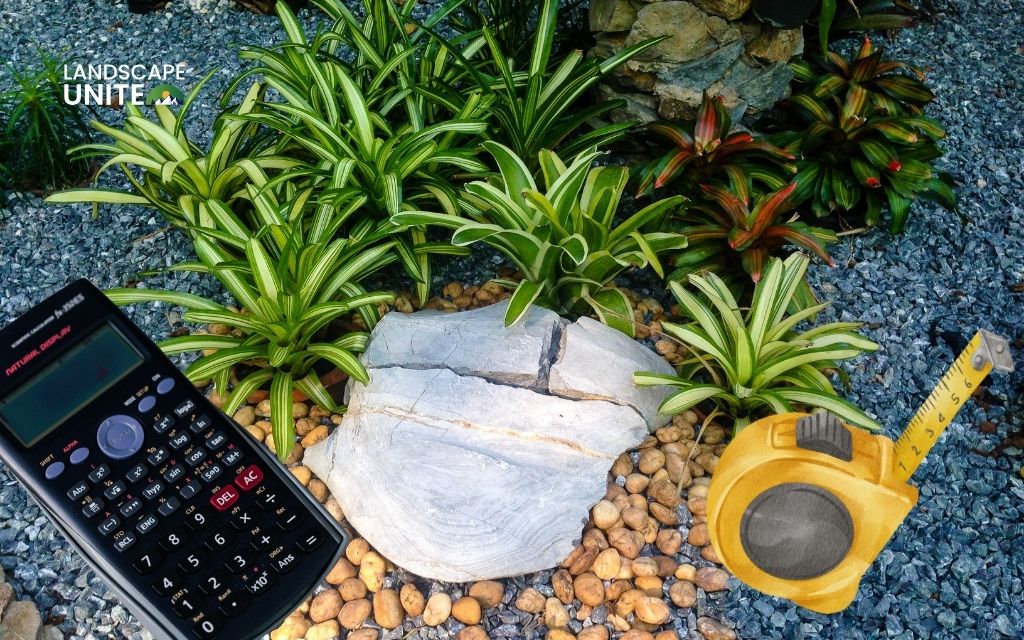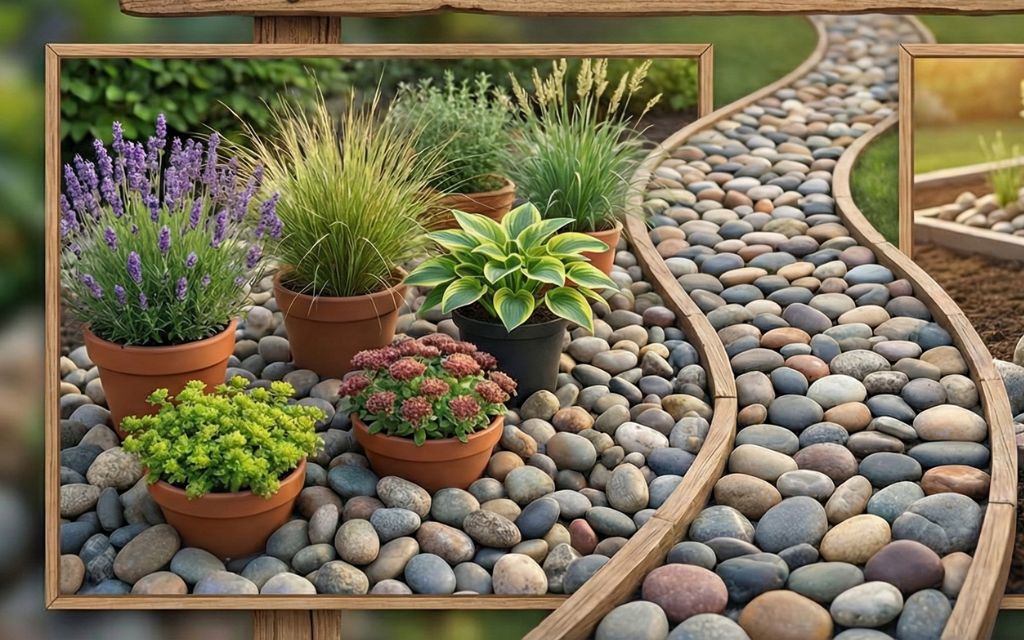Have your flowers suddenly wilted or your plants look like they’re dying from below? You might have grubs in your flower beds. These white, C-shaped creatures work silently underground, severing plant roots and creating havoc that often goes unnoticed until significant damage has occurred.
This comprehensive guide will help you identify, treat, and prevent grub infestations using both natural and chemical solutions.
Whether you’re dealing with a current infestation or want to protect your garden proactively, you’ll learn proven methods that professional landscapers use to maintain healthy flower beds.
How to identify a grub infestation
Recognizing grubs in flower beds early is crucial for effective treatment and minimizing plant damage. These underground pests often go undetected until substantial harm has occurred, making identification skills essential for every gardener.
Visible signs in plants
The first indicators of grub problems typically appear above ground in your plants themselves.
Sudden wilting despite regular watering is often the most noticeable early sign. Your flowers may appear thirsty and droopy even when soil moisture levels seem adequate, indicating that root damage is preventing proper water uptake.
Yellowing or thinning flower beds represent another telltale sign of grub activity.
Plants may exhibit stunted growth, reduced flowering, or patches of declining vegetation that seem to spread gradually across your garden. Unlike drought stress or nutrient deficiencies, grub damage often appears in irregular patterns as the larvae move through the soil.
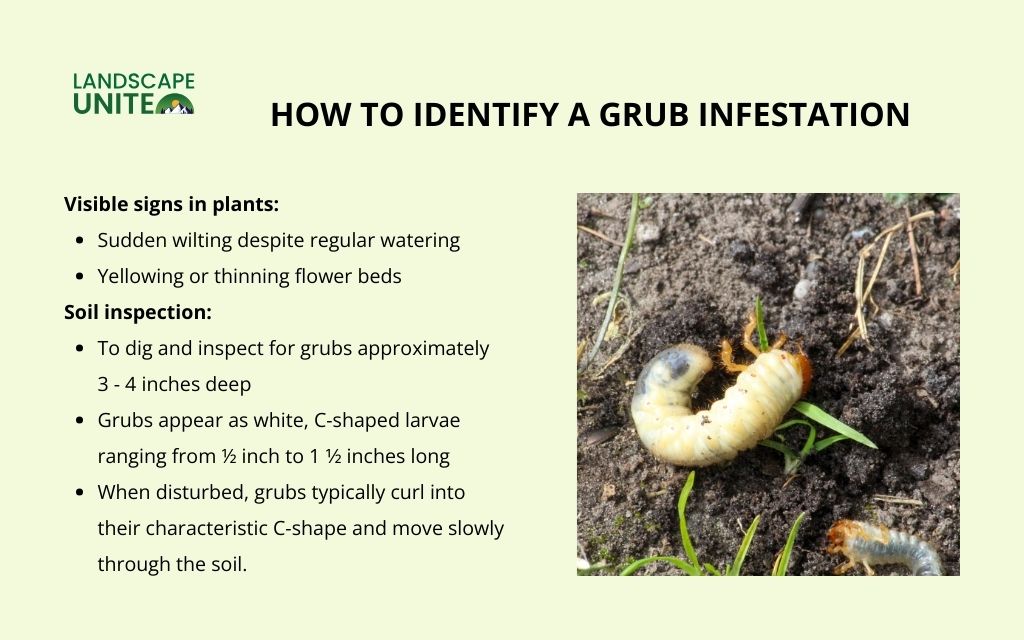
Soil inspection
Direct soil inspection provides the most definitive way to confirm grub presence in flower beds.
- To dig and inspect for grubs, use a small spade or trowel to carefully excavate a 6-inch square section of soil around affected plants, digging approximately 3 – 4 inches deep.
- Grubs appear as white, C-shaped larvae ranging from ½ inch to 1 1⁄2 inches long, depending on their species and maturity stage. They have cream-colored bodies with brown heads and six distinct legs near the head region. When disturbed, grubs typically curl into their characteristic C-shape and move slowly through the soil.
Healthy soil should contain fewer than five grubs per square foot. If you find 10 or more grubs in your sample area, you’re dealing with a significant infestation that requires immediate attention.
How to get rid of grubs in flower beds
Effective grub control for flower beds requires selecting the right treatment method based on infestation severity, timing, and your gardening philosophy.
Both organic and chemical options can successfully eliminate grubs when applied correctly.
Organic & natural methods
Beneficial nematodes
- Beneficial nematodes represent the gold standard for biological grub control in flower beds. These microscopic roundworms specifically target grub larvae without harming plants, beneficial insects, or soil health.
- Apply nematodes during evening hours when soil temperatures are between 60 – 85°F, typically in late spring or early fall.
- How they work: Nematodes enter grub bodies and release bacteria that naturally eliminate the pests within 7 – 14 days.
For application, mix nematodes with water according to package directions and apply using a sprayer or watering can.
Ensure soil remains moist for 2 weeks after application to maintain nematode viability. This method works best as a preventive treatment or for moderate infestations.
Milky spore disease
Milky spore disease offers long-term grub control specifically for Japanese beetle larvae. This naturally occurring bacterial disease establishes itself in soil and provides protection for 10 – 20 years once properly established.
Apply milky spore powder during warm weather when grubs are actively feeding, typically late summer through early fall.
Diatomaceous earth
Diatomaceous earth (food-grade only) works for surface treatments and newly hatched grubs. Sprinkle a thin layer over affected soil areas and water lightly to help it settle.
The microscopic sharp edges damage grub exoskeletons, leading to dehydration. Reapply after rain or heavy watering.
Handpicking
Handpicking proves effective for small infestations in contained flower bed areas. During morning hours when grubs are closer to the surface, carefully dig around affected plants and manually remove visible grubs. Drop collected grubs into soapy water to eliminate them humanely.
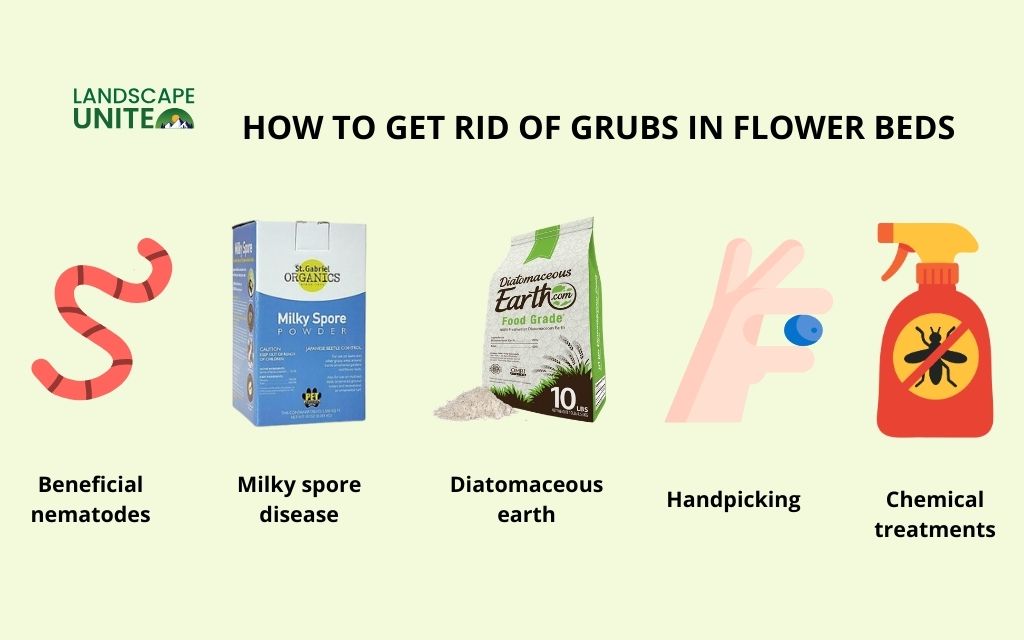
Chemical treatments
Chemical grub control becomes necessary when organic methods prove insufficient for severe infestations or when immediate results are essential to save valuable plants.
Professional-grade treatments can eliminate large grub populations quickly and effectively.
Best grub killers safe for flower beds include products containing imidacloprid, thiamethoxam, or clothianidin as active ingredients. These systemic insecticides are absorbed by plant roots and remain effective for extended periods.
Application timing and safety precautions are critical for chemical treatments. Apply granular grub killers in early to mid-summer before eggs hatch, or in early fall when young grubs are most vulnerable. Always water thoroughly after application to activate the product and move it into the root zone.
Safety notes:
- Wear protective equipment including gloves and long sleeves during application.
- Avoid applying on windy days or before expected rain.
- Keep pets and children away from treated areas until the product has been watered in and soil surface is dry.
Grub prevention tips for flower gardens
Preventing grubs in flower beds is more effective and economical than treating infestations. These proactive strategies create conditions that naturally discourage grub development.
- Regular soil health checks and aeration prevent grub problems at the source. Compacted soil attracts beetle egg-laying, so aerate flower beds annually using a core aerator or hand tools. Maintain soil pH between 6.0 – 7.0 for optimal plant health and natural pest resistance.
- Avoid overwatering, as moisture attracts beetles seeking egg-laying sites. Adult beetles prefer moist, soft soil for depositing eggs. Use deep, infrequent watering schedules that maintain plant health while avoiding constantly saturated soil conditions.
- Healthy planting practices with root diversity and proper spacing reduce grub attraction. Mix deep-rooted perennials with shallow-rooted annuals to create complex underground environments that discourage grub movement. Proper plant spacing promotes air circulation and reduces moisture retention that attracts beetles.
- Choosing grub-resistant flowers or companion planting provides natural protection. Marigolds, nasturtiums, and catnip naturally repel beetle species through their aromatic compounds. Native plant varieties support balanced ecosystems that naturally regulate pest populations while requiring less maintenance.
Grub control product recommendations
Selecting appropriate products for grub control in flower beds requires balancing effectiveness, safety, and environmental impact.
Eco-friendly and pet-safe products include beneficial nematode applications like NemaSeek or Grub Guard, which provide effective biological control without chemical residues. Milky spore products such as St. Gabriel Organics Milky Spore offer long-term protection specifically for Japanese beetle grubs.
For immediate organic intervention, food-grade diatomaceous earth from suppliers like Harris or Safer Brand provides safe surface treatment options.
These products won’t harm children, pets, or beneficial garden insects when used as directed.
Tips for applying grub control without harming pollinators:
- Focus on timing and product selection.
- Avoid applying any treatments during flower blooming periods when bees and other beneficial insects are most active.
- Choose systemic soil treatments over foliar applications to minimize pollinator exposure.
- Apply granular products during evening hours when pollinator activity is minimal.
- Water treatments thoroughly to move active ingredients below surface level where they won’t contact beneficial insects.
- Always read and follow product labels regarding pollinator protection requirements and timing restrictions.
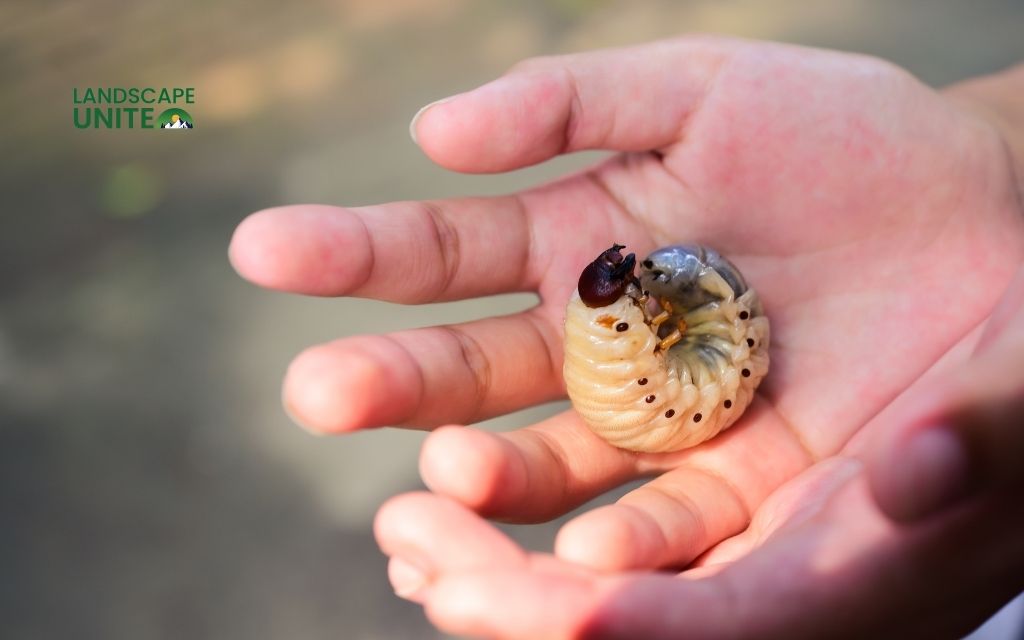
Conclusion
Grub infestations in flower beds are completely treatable and preventable with proper identification and treatment strategies. Early detection and choosing appropriate methods are key to success.
Start with organic treatments like beneficial nematodes and milky spores when possible, as these provide long-term protection without disrupting your garden’s natural balance. Use chemical treatments only for severe infestations threatening valuable plants.
Timing and consistency are crucial for effective grub control. Monitor flower beds regularly, especially during late summer when damage peaks, and maintain healthy soil conditions that naturally discourage pest establishment.
Regular soil monitoring and preventive measures will reward you with vibrant, healthy flowers that naturally resist grub problems while supporting beneficial garden insects.
Want additional creative gardening insights and advice? Explore our comprehensive article collection.
Frequently asked questions (FAQs)
What time of year are grubs most active in flower beds?
Grubs are most active during late summer through early fall (August-October) when they reach maximum size and feed aggressively. Damage often becomes visible in spring when plants struggle to recover from previous root damage. Adult beetles lay eggs during early to mid-summer (June-July).
Are grubs harmful to all types of plants?
Grubs primarily damage plants with fibrous root systems, including most annual flowers and shallow-rooted perennials. Deep-rooted perennials and established woody plants suffer less damage due to extensive root systems. Severe infestations can affect virtually any plant type.
Will grubs go away on their own?
No, grubs will not disappear without intervention. Adult beetles continue laying eggs annually in suitable locations, and populations typically increase over time without treatment.
Is it safe to use grub control around pets and pollinators?
Organic methods like beneficial nematodes and milky spore are completely safe. Chemical treatments require careful timing – avoid application during blooming periods, apply in evening hours, and choose soil treatments over foliar applications. Always follow product label safety instructions.
Can composting attract grubs to my garden?
Proper composting does not attract grubs. Well-managed compost reaching 140 – 160°F eliminates grub eggs and larvae. However, improperly managed compost with excessive moisture can attract adult beetles. Maintain proper carbon-to-nitrogen ratios and regular turning.
